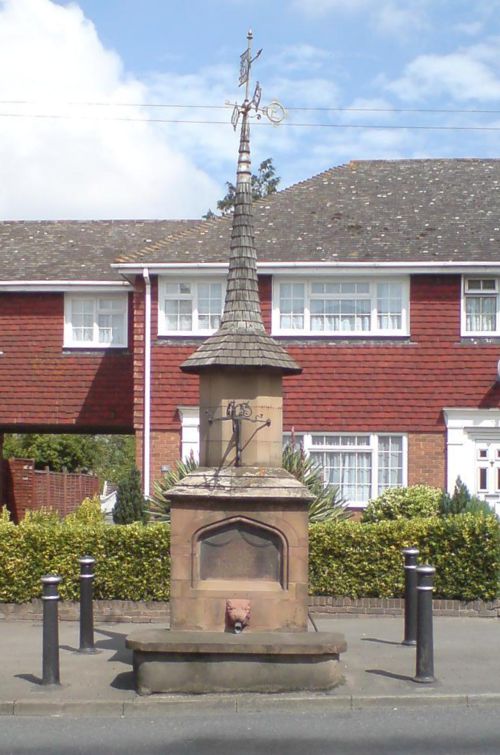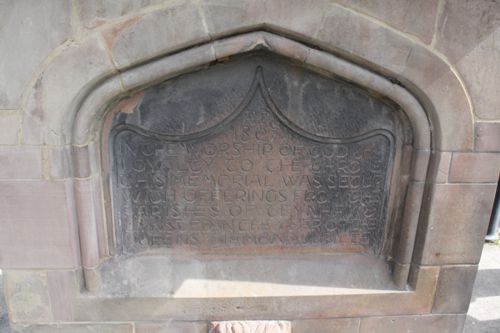Queen Victoria's Diamond Jubilee Commemorative Pump

A number of you will have passed it every day but perhaps have not had time to stop to read the inscription and perhaps wondered why it was there but have never asked. The older residents of Teynham will know, but do you?
The Queen Victoria’s Diamond Jubilee Pump is found along London Road (A.2) and is sited opposite the Dover Castle Inn. As the name implies it was erected to commemorate Queen Victoria’s Diamond Jubilee, but like most projects, events did not run smoothly.
Members of Teynham and Lynsted Parish Councils met on Saturday, 8th May 1897 to discuss how the Jubilee should be commemorated. One of the several ideas proposed was for a convalescent home but Dr. Selby believed this was unnecessary as the isolation hospital dealt with convalescent people. He then went on to suggest a pump, and drinking fountain be erected. This was met with approval and it was also thought that a trough for cattle should be added. The estimated cost £100. The design for the pump was submitted by Mr. Aymer Vallance.
In August of that year £105 had been raised but it was not enough to adopt the original design in its entirety. A request for further designs was made. In the meantime a village wag had erected a comic pump near the intended site as a hint to the Committee to get on with the job! In October further designs were submitted.
Saturday 19th February 1898 – [Operations for boring water for the pump had to be abandoned because an old cesspool was discovered underneath; since then matters had remained in abeyance.] On this particular Saturday inhabitants were surprised to see the hoarding around the suggested site of the pump had taken on a funereal aspect. A black flag and a miniature coffin dangled from a pole and a black edged placard bearing the inscription “In Memoriam of the late Jubilee Pump” had been placed at the site. Underneath there was an inscription to the Mayor and Burgesses of Greenstreet “lamenting the death of the Jubilee Pump” while below that were the significant words “Sleep on, Committee, sleep.” Mourning bows adorned the pole and the tolling of a bell solemnly sounded the death knell of the Jubilee Pump.
Saturday, 28th May 1898 – A correspondent writes:
‘Happening to be in Greenstreet the other day I strolled as far as the Mount where a singular construction at the roadside catches the eye of a passers-by. The body is somewhat squatty in proportion, constructed of stone it is surmounted by a long attenuated spire, vanishing almost to an invisible point on the top of which perches a vein. The roof work of the spire is of oaken tiles, suitably stained but unfortunately the colour has not proved very fast; the recent heavy rains have been more than the colour can stand and at the time of my visit the massive stonework was disfigured by ugly stains, which had washed down from the needle-pointed spire, indelibly smearing it after the fashion of a blotted page of copy-book. Closer inspection revealed the fact that this quaint and curious structure is unfinished for although there is a drinking trough at the side nearest the road yet at present there is not any means of raising the water to fill it – for I understand that a well has been sunk at this spot and that it was intended to erect a pump over it. But the requisite gear for raising the water still remains to be put in. And when it is completed I must confess that I fail to see how any human being, unless possessed by telescopic arms will be able to hold a pail under the pump on one side and manipulate the handle on the other. “But why was this extraordinary structure erected”, thought I. It is our memorial pump erected by the parishioners of Teynham and Lynsted to commemorate the Queen’s Diamond Jubilee “, said a resident. “But the Jubilee festivities have long passed and we are nearly half way through another year”, I remarked. “Yes, that’s right enough”, said my communicative friend, “but”, he added with a merry twinkle in his eye, “it will be finished by the time Her Majesty celebrates the seventieth year of her reign!”
Armed with this information, I again viewed this incongruous combination of beauty and ugliness with renewed interest and then learned that the reason the work is at a standstill is that the architect will not pass it.
Saturday, 31st December 1898 – A condemned well. An analyst’s report of a sample of water from the first well sunk for the purpose of supplying the Jubilee Pump showed it to be unsafe for drinking. A favourable report upon a Conyer water supply was however considered at the meeting.
Eventually the Pump was built, albeit after the Diamond Jubilee. A joint Committee of Teynham and Lynsted Parish Councillors oversaw the building of the Pump and the inscription on the front of the Jubilee Pump, as pictured opposite, reads as follows:
“AD 1897 In the worship of God and loyalty to the throne this memorial was set up with offerings from the Parishes of Teynham and Lynsted in the year of the Queen’s Diamond Jubilee".
Refurbishment work was carried out in 1992 to the front. Unfortunately the Pump sustained some damaged in March 2003 and because of the particular type of stone used at the time of refurbishment took sometime yet before the repairs were complete.
During Spring 2003, as a joint project between Teynham Parish Council and Lynsted with Kingsdown Parish Council, four ornamental metal bollards, painted black with gold banding around the top (as seen in the top photograph), were installed around the pump to protect it against further impact damage.
Chris McIlroy, Clerk to the Parish Council